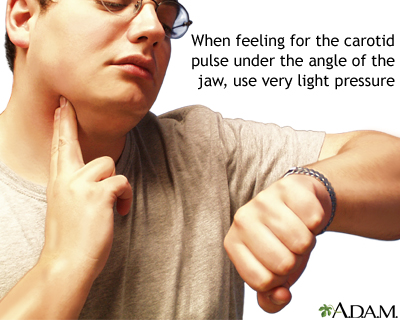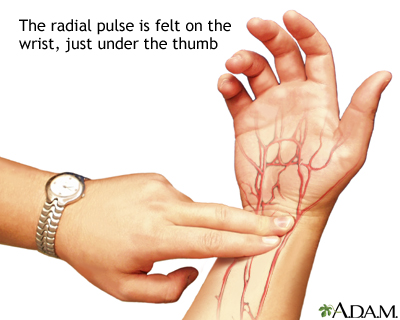Health Topics
Heart bypass surgery creates a new route, called a bypass, for blood and oxygen to reach your heart muscle.
Minimally invasive coronary (heart) artery bypass can be done without stopping the heart. Therefore, you do not need to be put on a heart-lung machine for this procedure.
This article discusses what you need to do to care for yourself after you leave the hospital.
When You're in the Hospital
You had minimally invasive coronary artery bypass surgery on one or more of your coronary arteries. Your surgeon used an artery from your chest to create a bypass, around arteries that were blocked and could not bring blood to your heart. A 3- to 5-inch-long (7.5 to 12.5 centimeters) cut (incision) was made in the left part of your chest between your ribs. This allowed your surgeon to reach your heart.
What to Expect at Home
You may be able to leave the hospital 2 or 3 days after surgery. You may also be able to return to normal activities after 2 or 3 weeks.
After surgery, it is normal to:
- Feel tired.
- Have some shortness of breath. This may be worse if you also have lung problems. Some people may use oxygen when they go home.
- Have pain in the chest area around the wound.
Self-care
You may want to have someone stay with you in your home for the first week.
Learn how to check your pulse, and check it every day.


Do the breathing exercises you learned in the hospital for the first 1 to 2 weeks.
Weigh yourself every day.
Shower every day, washing your incision gently with soap and water. Do not swim, soak in a hot tub, or take baths until your incision is completely healed. Follow a heart-healthy diet.
If you are feeling depressed, talk with your family and friends. Ask your surgeon or health care provider about getting help from a counselor.
Continue to take all your medicines for your heart, diabetes, high blood pressure, or any other conditions you have.
- Do not stop taking any medicine without talking with your provider.
- Your provider may recommend antiplatelet drugs (blood thinners) -- such as aspirin, clopidogrel (Plavix), prasugrel (Effient), or ticagrelor (Brilinta) -- to help keep your artery graft open.
- If you are taking a blood thinner such as warfarin (Coumadin), you may have extra blood tests to make sure your dose is correct.
Activity
Stay active during your recovery, but start slowly. Ask your surgeon how active you should be.
- Walking is a good exercise after surgery. Do not worry about how fast you walk. Take it slow.
- Climbing stairs is OK, but be careful. Balance may be a problem so use the railing. Rest halfway up the stairs if you need to.
- Light household chores, such as setting the table and folding clothes should be OK.
- Slowly increase the amount and intensity of your activities over the first 3 months.
- Do not exercise outside when it is too cold or too hot.
- Stop if you feel short of breath, dizzy, or any pain in your chest. Avoid any activity or exercise that causes pulling or pain across your chest, such as using a rowing machine or weight lifting.
- Keep your incision area protected from the sun to avoid sunburn.
Be careful how you use your arms and upper body when you move around for the first 2 or 3 weeks after your surgery. Ask your surgeon when you may return to work. For the first week after surgery:
- Do not reach backward.
- Do not let anyone pull on your arms for any reason -- for instance, if they are helping you move around or get out of bed.
- Do not lift anything heavier than about 10 pounds (4.5 kilograms). (This is a little more than a gallon, or 4 liters, of milk.)
- Avoid other activities in which you need to keep your arms above your shoulders for any period of time.
- Do not drive. The twisting involved in turning the steering wheel may pull on your incision.
You may be referred to a cardiac rehabilitation program. You will get information and counseling about activity, diet, and exercise.
When to Call the Doctor
Contact your surgeon or provider if:
- You have chest pain or shortness of breath that does not go away when you rest.
- Your pulse feels irregular -- it is very slow (fewer than 60 beats a minute) or very fast (over 100 to 120 beats a minute).
- You have dizziness, fainting, or you are very tired.
- You have a severe headache that does not go away.
- You have a cough that does not go away.
- You are coughing up blood or yellow or green mucus.
- You have problems taking any of your heart medicines.
- Your weight goes up by more than 2 pounds (1 kilogram) in a day for 2 days in a row.
- Your wound is red or swelling, it has opened, or there is more drainage coming from it.
- You have chills or a fever over 101°F (38.3°C).
Alternative Names
Minimally invasive direct coronary artery bypass - discharge; MIDCAB - discharge; Robot assisted coronary artery bypass - discharge; RACAB - discharge; Keyhole heart surgery - discharge; Coronary artery disease - MIDCAB discharge; CAD - MIDCAB discharge
References
Morrow DA, de Lemos JA. Stable ischemic heart disease. In: Libby P, Bonow RO, Mann DL, Tomaselli GF, Bhatt DL, Solomon SD, eds. Braunwald's Heart Disease: A Textbook of Cardiovascular Medicine. 12th ed. Philadelphia, PA: Elsevier; 2022:chap 40.
Omer S, Bakaeen FG. Acquired heart disease: coronary insufficiency. In: Townsend CM Jr, Beauchamp RD, Evers BM, Mattox KL, eds. Sabiston Textbook of Surgery. 21st ed. St Louis, MO: Elsevier; 2022:chap 60.
Virani SS, Newby LK, Arnold SV, et al. 2023 AHA/ACC/ACCP/ASPC/NLA/PCNA guideline for the management of patients with chronic coronary disease: a report of the American Heart Association/American College of Cardiology Joint Committee on Clinical Practice Guidelines. Circulation. 2023;148(9):e9-e119. PMID: 37471501 pubmed.ncbi.nlm.nih.gov/37471501/.
Patient Instructions
- Angina - discharge
- Angina - what to ask your doctor
- Angina - when you have chest pain
- Antiplatelet medicines - P2Y12 inhibitors
- Aspirin and heart disease
- Being active after your heart attack
- Being active when you have heart disease
- Butter, margarine, and cooking oils
- Cholesterol and lifestyle
- Controlling your high blood pressure
- Dietary fats explained
- Fast food tips
- Heart attack – discharge
- Heart attack - what to ask your provider
- Heart bypass surgery - discharge
- Heart disease - risk factors
- How to read food labels
- Mediterranean diet
Review Date 7/14/2024
Updated by: Michael A. Chen, MD, PhD, Associate Professor of Medicine, Division of Cardiology, Harborview Medical Center, University of Washington Medical School, Seattle, WA. Also reviewed by David C. Dugdale, MD, Medical Director, Brenda Conaway, Editorial Director, and the A.D.A.M. Editorial team.






